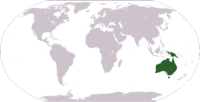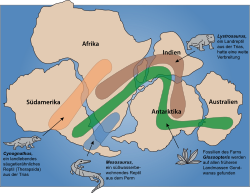Australia (continent)
Australia

![]()
Australia as a continent comprises a main land mass, the Australian mainland, and the offshore islands of Tasmania and New Guinea. Often the continent of Australia is also grouped together with the island states located in the Pacific Ocean, especially New Zealand for cultural and political reasons. This extended region is referred to as Australia and Oceania.
The main landmass was formerly also called New Holland, and the continent is counted (from a European perspective) as the Fifth Continent.
Historical geology
→ Main article: Geology of Australia
The continent of Australia lies on the Australian continental plate, which is seen as part of the larger Indo-Australian plate. In addition to Australia in the narrower sense and New Guinea, this includes the northern part of New Zealand as well as the eastern Indian Ocean, the Indian subcontinent and part of the southwest Pacific. The Australian continent is now moving northeast at a rate of 73 mm per year.
Originally, the continent Australia was part of the southern large continent Gondwana, that began to separate again from the "original continent" Pangaea from the late Triassic approximately 230 million years ago.
In the Jurassic, about 180 million years ago, Gondwana also gradually began to break up into today's "southern continents". At the beginning of the Late Cretaceous, about 95 million years ago, the continental blocks of South America, Africa-Arabia, Indo-Madagascar and Australo-Antarctica had largely separated. However, the young ocean basins between these blocks were still relatively narrow. Later in the Late Cretaceous, India broke away from Madagascar, drifted rapidly northeastward in the Paleocene, and collided with Eurasia about 50 million years ago in the Eocene. Madagascar, on the other hand, remained close to Africa. Although the earliest phase of the separation of the Australian continent from Antarctica began in the early Cretaceous, it remained near Antarctica until the Paleocene and did not begin to migrate rapidly northward until the Eocene. The separation of Zealandia (with New Zealand) from Australo-Antarctica was relatively advanced by this time. In the Oligocene, about 25 million years ago, the Australian continent collided with an island arc in the southwest Pacific, the precursor of today's Mariana Islands and Palau Ridge, causing the mountains of New Guinea to fold up. During the Miocene, about 15 million years ago, the Australian continent began to brush the southeastern tip of Eurasia (i.e., present-day Southeast Asia), and gradually the present situation formed. During the Pleistocene, Australia, New Guinea and Tasmania were one continuous land mass, Sahul, due to the low sea level worldwide. It was not until about 12,000 years ago that the Bass Strait was flooded, and finally, 8000 years ago, the Torres Strait was flooded and with it the land links between Australia and Tasmania and New Guinea.

The distribution of fossils of Cynognathus, Mesosaurus, Lystrosaurus and the Glossopteridales on today's continents (strongly schematic representation, the colored areas do not correspond to the actual finding regions) confirms the former existence of the large continent Gondwana.
Geography
→ Main article: Geography of Australia
The continent of Australia comprises a main land mass, Australia proper, the offshore islands of Tasmania, New Guinea, which is also called Papua or Irian, and several island groups and smaller islands such as Salawati, Misool, the Aru Islands, the Biak Islands, Yapen, the Lusancay Islands, Muyua ("Woodlark"), the D'Entrecasteaux Islands, the Kiriwina Islands ("Trobriand Islands") and the Louisiade Archipelago. The northernmost point is directly on the equator, on Kabare Island; to the south the continent extends to the southeast cape on Tasmania at 43° south. The east-west extent is from Cape Byron at 153 degrees longitude east to Cape Inscription at 113 degrees longitude east.
With an area of 8,500,000 km², the continent is almost as large as Europe. The land mass of Australia without offshore islands is about 7.600.000 km² and is still more than three times as big as the biggest island of the earth, Greenland. Therefore, Australia is rarely called an island, one also finds the term island continent. The following states lie completely or partially on the continent:
- Australia (whole)
- Papua New Guinea (whole)
- Indonesia (western part of the island of New Guinea)
Australia is characterized by its dry, flat hinterland. In the east, the flat centre is bordered by the Great Dividing Range, which reaches a height of 2228 m with Mount Kosciuszko. This mountain range extends to Victoria in the southeast. In the sparsely populated west of the continent are the Australian deserts, such as the Nullarbor Desert. These flat landscapes are only occasionally interrupted by elevations such as the MacDonnell Ranges. A prominent landmark of the Australian mainland is the island mountain Uluṟu, at the foot of which lie several sacred Aboriginal sites.
In contrast to the rest of the continent, New Guinea is home to highly rugged mountains due to the collision with the Eurasian continental plate. A mountain range about 200 km wide crosses the entire island from west to east. Here are the highest mountains of the continent, the Puncak Jaya with 4884 m and Mount Wilhelm with 4509 m.
Australia's most famous rivers include, for example, the Darling River, Murray River, Snowy River and the Sepik. The interior is poor in freshwater reservoirs, large salt lakes such as Lake Eyre determine the landscape. Lake Eyre, at 15 m below sea level, is also the lowest point in Australia.

Location of the continent Australia
Search within the encyclopedia